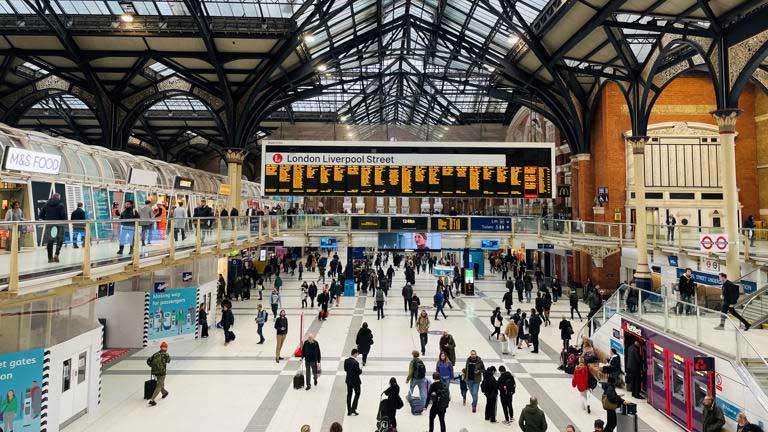The Liverpool Street Station overhaul could be completed by 2032, contingent on funding through a 13-storey office block development above the station, according to The Standard.
Network Rail’s latest plans aim to expand capacity and improve facilities at one of the UK's busiest railway hubs. Architect Friedrich Ludewig envisions a “gothic cathedral-like” design, giving the station “four fronts.”
Robin Dobson, Network Rail Property's Group Director, emphasized protecting the station’s Victorian heritage, while stressing the urgent need for upgrades to accommodate 150 million passengers annually over the next 40 years.
Due to strong opposition to its plan for a tower on top of the Grade II*-listed old Great Eastern Hotel, now known as the Andaz hotel, Network Rail withdrew its support for a concept from the real estate company Sellar, according to an article published by The Standard on Monday.
To find out more about the new plans, Mr. Dobson and Mr. Ludewig invited the Standard to have a tour of the station. These are the salient points.
What was wrong with the Sellar ‘skyscraper’ plan?
The original £1.5bn plan for Liverpool Street station, proposed in October 2022 by Sellar—the firm behind The Shard at London Bridge—was developed in partnership with Network Rail, Hyatt Hotel Group (owner of the Andaz), and Elizabeth Line operator MTR.
The proposal involved constructing a 16-storey tower atop a five-storey hotel, making it a 21-storey building in total. This plan sparked strong opposition from conservationists, including Historic England and the Victorian Society, led by actor Griff Rhys Jones.
Network Rail hoped that the over-station development would help fund £450m in capacity improvements at no cost to taxpayers or fare payers, including step-free access to all Tube platforms.
What is different about the new plans?
Network Rail, which owns Liverpool Street train station, says it is now “taking the lead”, as opposed to having a developer call the shots.
It has “taken stock” in response to the scale of the objections to the Sellar plan, and has a “new team and new approach”. It is also revising passenger forecasts in light of the latest post-pandemic travel patterns.
Mr Dobson said: “What’s clear is that [Liverpool Street] gets over 100m passengers a year. That is due to grow to over 150m over the next 40 years. The need to deliver a new station is so important.”
Network Rail has side-stepped questions about its current relationship with Sellar, whose planning application is still live on the City of London Corporation’s website. Sellar did not respond to a request for comment.
The office block that Network Rail is now proposing would be 11m shorter than the Sellar skyscraper: its highest point would be 97m from ground level, as opposed to 108m.
In addition, it would have between three and seven fewer storeys than the Sellar plan – so a maximum of 13 storeys rather than 16.
In addition, the office block would be “stepped” – meaning it varies in height across the development – with corners “pared back” to prevent it blocking views of St Paul’s Cathedral.
The fundamental change is that the office block would not be built on top of the hotel, but back from the station’s main façade – effectively over the top of the concourse.
What are the benefits of the new plans?
Mr Ludewig said the station’s Victorian train sheds, which date from the 1870s, were “quite beautiful but we have lost a bit of visibility” of them, and “there is no sense of the building having a presence”.
He said: “What the City of London and others have said to us is: ‘It is surprising that for the busiest train station in the UK, you have to keep explaining to people where it is.’
“It doesn’t have a facade. It doesn’t have a front door. From Bishopsgate, it’s ‘go up to Tesco and turn left’. If you come from Old Broad Street, it takes quite a while before you see it, because it’s been set back.
“If you are a normal person going to Shoreditch or Brick Lane, we would like the station to not have ‘one front and three backs’ any more. We would like the station to have four fronts.
“We are working hard with our neighbours to make the station open to Exchange Square and open to Broadgate Circus.”
Mr Ludewig added: “We would like the retail [space] to be bigger and better, without blocking sightlines of the Victorian train shed.
“We would like people in the future not just to think of the station as a shortcut, but as a place where the retail is as good as St Pancras, [King’s Cross or London Bridge], where you find retailers you don’t find everywhere else.”
What is the timeline?
The aim is to submit a planning application by December 2024. Sources believe that the City of London Corporation is keen to make a decision quickly.
A developer for the new office building – which would be held up by new “21st century heritage” columns in the station concourse – has yet to be announced.
There would be a two-year gap between planning consent being awarded and construction starting. “There would be a start on-site in 2027/28 and a five-year project,” Mr Dobson said.
Asked if the new station would be completed by 2033, her replied: “Earlier if we can get to grips with moving forward.”
What will the “new” station look like?
Mr Ludewig, founding director of the Shoreditch-based practice ACME, wants to create a “sense of theatre”.
The key changes will be the access to and from the station, and the views within it. There will be new direct access, via the upper concourse, onto Exchange Square, at the northern end of the station.
Mr Ludewig said: “There will be daylight coming into the concourse.
“The main perception of the station we have heard from other people is that it feels like a gothic cathedral.
“Gothic cathedrals don’t have glass roofs. Gothic cathedrals have a sense of height, and sunlight coming in from one side. In that sense, it will be a very tall, gothic cathedral-like space again.”
There will be a larger concourse, a bigger Tube ticket hall, and public toilets at all levels. There will be step-free access to the Central line and the sub-surface Tube lines, such as the Circle line.
“It means a new concourse, new ticket areas, new ticket barriers and importantly more capacity for all of [Liverpool Street’s] commuters and its users,” Mr Dobson said.
“It means a new retail and new F&B (food and beverage) experience, new step-free access across the whole of the estate, and importantly really opening up the key routes through the station – east and west, and also north and south.
“This is delivered by a new office block that sits above the new station, back off the Great Eastern Hotel, that funds these improvements that are so desperately needed.
“We are not touching any of the Victorian train sheds as part of this solution. We are trying to celebrate the heritage environment that Liverpool Street station sits in.”
Will Liverpool Street station remain open during the construction works?
Yes. Platforms 15 and 16, which used to be used for the Elizabeth line prior to “through running”, are currently unused. The aim is to utilise these when other platforms are closed.
What happens if the office block is refused planning permission?
The station upgrade will not go ahead. Network Rail is reliant on income from the over-station development to fund the changes to the station.
Mr Dobson said: “Delivering the office building above the concourse is really important in terms of self-funding the new station. This is a really exciting project.”
_8.jpg)







.svg)

_6.jpg)